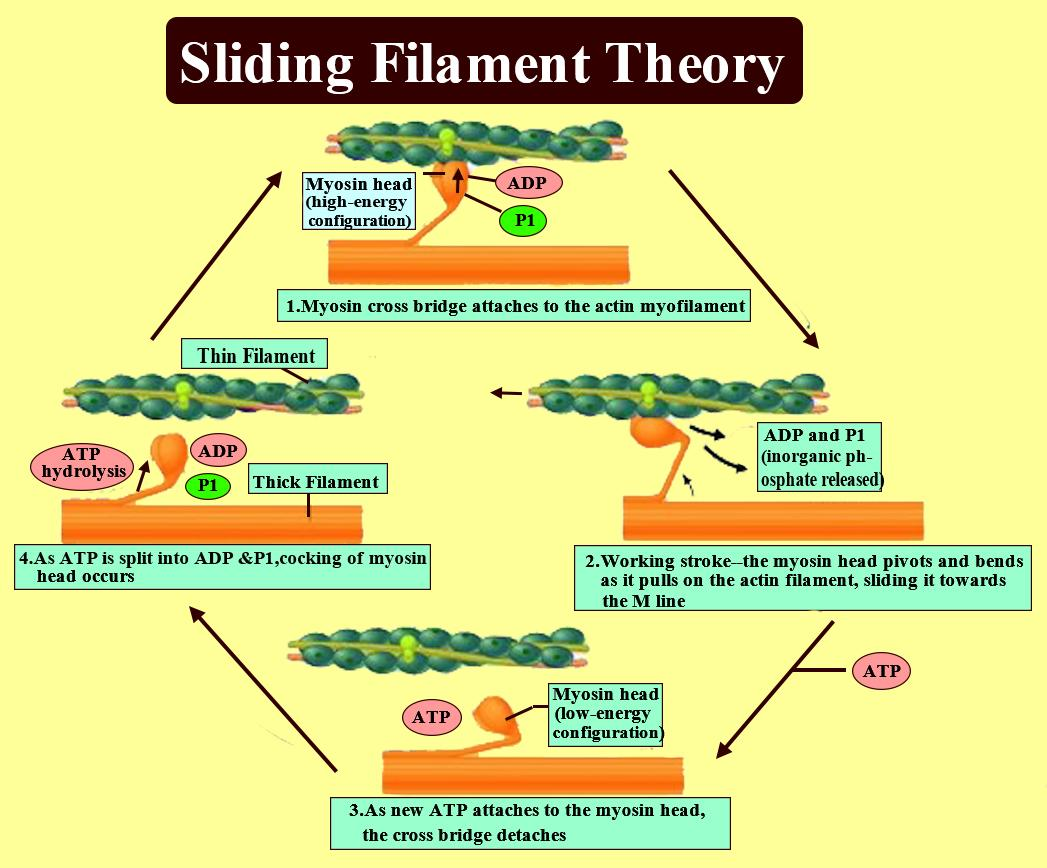Of the Following Which Best Describes the Sliding Filament Theory
Dont use plagiarized sources. View the primary ISBN for.

Sliding Filament Theory Can Be Best Explained As Aactin Class 11 Biology Cbse
Actin and myosin filaments shorten and slide past each other.

. A A molecule of ATP binding to the myosin head. Muscles contract in order to move limbs or maintain a certain position or posture. Which of the following statements best describes the sliding filament mechanism of muscle contractiona.
This theory was proposed by HE Huxley and J. Actin and myosin filaments do not shorten but rather slide past each other. According to the sliding filament theory of muscle contraction the physical changes that occur in the sarcomere during contraction are a result of the thin filaments sliding past the thick filaments resulting in shortening of all the sarcomeres in a myofibril.
Actin thin filaments combined with myosin thick filaments conduct cellular movements. 2The binding of myosin to actin. It stimulates the sarcoplasmic reticulum to release calcium ions.
The myosin and actin can cross bridge. According to the sliding filament theory the myosin thick filaments of muscle fibers slide past the actin thin filaments during muscle. This mechanism is explained by the sliding filament theory.
The striated pattern of skeletal muscle viewed under the microscope is created by the regular arrangement. Which of the following best describes the diagram. Impulse arrives at neuromuscular junction.
The arrangement of actin and myosin myofilament within a sarcomere is crucial in the mechanism of muscle contraction. B The hydrolysis of an ADP molecule on the actin filament. Sliding Filament Theory of Muscle Contraction.
The mechanism of muscle contraction is explained by sliding filament model. Begin with what triggers it calcium being released into the cell and discuss all events through cross-bridge formation and cycling. Science Anatomy and Physiology QA Library Which of the following best describes the diagram.
Be sure to use the terms actin and myosin in your answer. At a very basic level each muscle fibre is made up of smaller fibres called myofibrils. Describe the sliding filament theory.
5The hydrolysis of ATP which leads to re-energizing. As they slide past each other actin filaments shorten but myosin filaments do not shorten. In the sliding filament theory of muscle contraction what initiates the detachment of the myosin head from the binding site on the actin filament.
A sarcomere in relaxed above and contracted below positions. A filament of myosin during cross bridge cycling. Describe the change that occurs in the myosin molecule between stage 1 attachment and stage 2.
Actin and myosin filaments do not shorten but rather slide past each otherb. Actin and myosin filaments shorten and slide past. Which of the following best describes the diagram.
1 The release of acetylcholine along the motor neurons stimulating muscle contraction 2 Thick and thin filaments slide past one another to form muscle contractions 3 A neurotransmitter sends an impulse from one filament to the other enabling the muscle to lengthen thus creating. The diagram above shows part a myofibril called a sarcomere. Biology 9th Edition Edit edition Solutions for Chapter 47 Problem 4U.
The sliding filament theory explains the mechanism of muscle contraction based on muscle proteins that slide past each other to generate movement. These filaments slide in and out between each other to form a muscle contraction hence called the sliding filament theory. Which statement describes the sliding-filament theory.
The calcium attaches to the troponin which removes tropomysosin from the myosin binding site on actin. And 1 to put the following events in. One motor unit An inactive actin filament The sliding filament theory.
1The influx of calcium triggering the exposure of the binding sites on actin. These contain even smaller structures called actin and myosin filaments. Biology 9th Edition Textbook Solutions.
4The binding of ATP to the cross bridge which results in the cross bridge disconnecting from actin. The Sliding Filament Theory is a description of the process of muscular contraction. Muscle Histology Review.
A filament of myosin during cross bridge cycling. Describe the sliding filament theory of muscle contraction. The sliding filament theory is a suggested mechanism of contraction of striated muscles actin and myosin filaments to be precise which overlap each other resulting in the shortening of the muscle fibre length.
The actin and myosin interact and the actin is pulled over the myosin shortening the sarcomere. In 1954 two researchers Jean Hanson and Hugh Huxley from the Massachusetts Institute of Technology made a model for muscle tissue contraction which is known as the sliding filament theoryThis theory describes the way a muscle cell contracts or shortens as a whole by the sliding of thin filaments over thick filaments and pulling the Z discs. This process is triggered by the release of calcium ions in the presence of the proteins.
Up to 24 cash back The Sliding Filament Theory How do muscle cells contract Model 1. Sliding filament theory. Which of the following statements best describes the sliding filament mechanism of muscle contraction.
Which ONE of the following best describes the term sliding filament theory. Sliding filament theory describes the muscle contraction theory. However for the muscle as a whole to contract the actin and myosin filaments must overlap causing the sarcomere to shorten.
3The power stroke of the cross bridge that causes the sliding of the thin filaments. One motor unit ОО An inactive actin filament The sliding filament theory O.

Sliding Filament Theory Muscle Contraction 6 Steps D Diagram Quizlet


Comments
Post a Comment